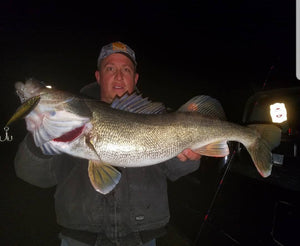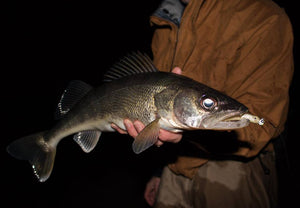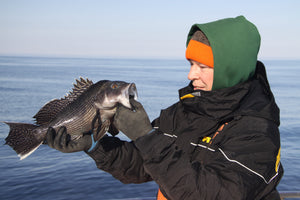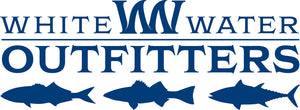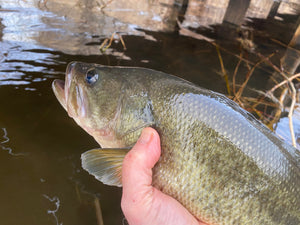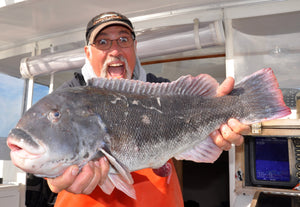Jig Shallow for Early Fluke

Early spring can see some real doormats taken on Long Island’s East End. OutdoorTom.com photo.
Okay fluke fans, it’s time to get cracking. While the past several seasons have admittedly seen a lackluster overall performance by the summer flatties, the past two years have each witnessed slight improvement in local catches. In both instances, catch rates seemed to be best in May and early June, and then again during the last month before the season wrapped up.
For 2025, we’ll once again have a split season for the tasty flatfish with a slightly different size limit for each half. From May 4 through August 1, anglers fishing in New York waters will be allowed to keep up to three fluke each per day with a minimum size limit of 19 inches. From August 2 through October 15, the daily creel limit remains at three with the size limit stretching to 19.5 inches. That equates to a fish weighing just about 3 pounds.
 A white and pink bucktail combines two top colors for tempting fluke. Tipped with a single spearing or thin strip of squid, this is a consistent producer of shallow-feeding fluke in May and June. OutdoorTom.com photo.
A white and pink bucktail combines two top colors for tempting fluke. Tipped with a single spearing or thin strip of squid, this is a consistent producer of shallow-feeding fluke in May and June. OutdoorTom.com photo.
Back in the days when fluke were more plentiful, there was a pretty hot debate as to whether one should target the summer flatties with bait or jigs. Jigs, it was generally believed, inspired plenty of action but tended to catch smaller fish on an overall basis. These days, however, it’s more of a toss-up. With the fish spread further apart, there’s a lot to be said in favor of jigging as it allows anglers to cover more water quickly and with a far more active technique. It’s also just a ton of fun and, as the technique has been tweaked from year to year, it’s now a proven way to catch keepers as well. Dragging fish strips, squid pennants or spearing and squid combos still has its place, of course, but it seems to do best later in the season when the fluke are biting in deeper water where the depth and currents can make holding bottom with lightweight jigs more of a challenge.
If you’d like to take the jigging route as the season opens in May, you can bet the summer flatties will be looking for warm water and plenty of bait. For that reason, it makes sense to start your search inside the bays. Here on the East End of Long Island, both Peconic and Shinnecock bays have plenty of moderately shallow areas that tend to warm fairly quickly. It’s in these spots where you’ll likely connect first. While it’s possible to jig fluke from four- to six-foot depths this time of year, consider eight to 12 feet as being prime water. Here you’ll likely have the most success – and most fun – if you attack it with the right gear.
 Sluggish feeding fluke in cool water often respond well to small teasers tipped with spearing or a thin strip of squid. OutdoorTom.com photo.
Sluggish feeding fluke in cool water often respond well to small teasers tipped with spearing or a thin strip of squid. OutdoorTom.com photo.
To that end, choose a lightweight jigging rod and reel combo, tie on a ½- to 1-ounce OG (formerly S&S) Big Eye or Fish Head bucktail in pearl white, spearing, chartreuse or pink/white, and tip your jig with a four or five-inch white, pink shine or nuclear chicken Berkley Gulp!® Saltwater Jigging Grub, Jerk Shad or Swimming Mullet. If the water is still relatively cold, favor the Jerk Shad for its gentle action. As things heat up, opt for the grub or swimming mullet.
In terms of rods, Tsunami’s new Forged Snap Jigging series spinning rods are a great match for this style of fishing as they can double as bay fluke jigging sticks and lightweight bass/weakfish/bluefish snap jigging inshore outfits. St. Croix’s Premier line works very well, too, and does a nice job of blending just the right amount of sensitivity with sticking power. With either choice you want a 6- to 6-1/2-foot medium-light model matched to a Shimano Stradic FM, Daiwa BG MQ or Penn Battle spinning reel in the 2500 size.
Since bay jigging is all about getting to the bottom with minimal weight and maximum sensitivity, we suggest 10- to 15-pound test Power Pro braided line or Daiwa J-Braid x8 for this application. Both are ultra-strong and super-sensitive, making them solid choices. Grab a high visibility bright color like chartreuse, yellow or multi-color so you can see the line twitch easily on light strikes - but do add a four- to five-foot length of 12- to 15-pound-test Seaguar Blue Label leader material to keep your presence as inconspicuous as possible.
As a general rule, you’ll find the best fluke action early in the season at the start of outgoing tide as warmer water from deep inside the bays is pulled out toward the main channels, inlets and harbor mouths. During the heat of summer, however, cooler rising waters tend to trigger the bite. Either way, it helps a lot to experiment throughout the day with different jigging cadences.
 Keeper fluke have no qualms about eating small baits early in the season. This one spat up a local shrimp when it hit the deck. OutdoorTom.com photo.
Keeper fluke have no qualms about eating small baits early in the season. This one spat up a local shrimp when it hit the deck. OutdoorTom.com photo.
Keep in mind that with the water still a bit cold this time of year, a slow, gliding, gentle jigging cadence can be especially effective in May and early June if you can keep your lure just a few inches above the bottom between bounces every few feet. As the water warms, or if the fish simply seem increasingly aggressive, quicken the jigging pace and shorten the distance between bottom bumps. At the height of the bite, you might even want to jig straight up and down, trying to bounce your jig almost in place beneath your drifting vessel. If all that fails to light-up the flatties, snap jigging is yet another approach worthy of a try.
Many fluke anglers enjoy taking long drifts for fluke and will basically stay the course if they pull up a keeper now and hen. That’s fine if it works for you, but as a rule the best fluke fishing tends to be concentrated in relatively narrow zones, often simply within the stretch that lies between the buoys marking channel edges. While it may be possible to drift and stay within a channel for quite some time if the wind is blowing favorably, most days will see you crossing or quartering. Under such conditions, consider keeping drifts relatively short in an effort to maintain your offerings within the primary strike zone for the greatest amount of time.
One last thought on jigging early-season fluke: Should the flatties seem a little lethargic, adding a smallish bucktail teaser a foot above the jig can be a good idea. That smaller target, tipped with a spearing or thin pennant of squid, might better match the small baitfish, grass shrimp and other fodder that floods the bays this time of year. It can also increase your by-catch of weakfish. Just be aware that a high hook can be a double-edged sword if the sea robins are abundant. In that case, working a single jig right along the bottom is likely your best bet.
- Bryce Poyer

